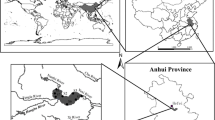Abstract
In order to assess the condition of heavy metal pollution in the Yellow River, Lanzhou section, China, and to quantify heavy metal (copper, lead, zinc, and cadmium) contents in tissues (liver, kidney, gills, and muscles) of two fish species (Triplophysa pappenheimi and Gobio hwanghensis), levels of these four metals in the water body, sediment, and tissues of the two fish were measured using inductively coupled plasma-atomic emission spectrometry. The metal levels from this study were compared with the threshold values in the guidelines of water, sediment, and food given by the National Environmental Protection Agency of China, the National Oceanic and Atmospheric Administration of America, and the National Standards Management Department of China. We found the mean concentrations of Cu, Pb, Zn, and Cd in THE water body, sediment, and muscles of two fish species were far below the values in guidelines. We also found that the type of metals present and their concentrations varied in different tissues and species. The results suggested that (1) Cu, Pb, Zn, and Cd did not contaminate the aquatic ecosystem severely and did not threaten the safety of human consumption in the Yellow River, Lanzhou section, and (2) organs that are sensitive to accumulating heavy metals may be useful to develop bioindicators for monitoring metal contamination. Considering environmental variables, further study is necessary before deciding which fish species or tissue could be the ideal bioindicators for aquatic pollution.
Similar content being viewed by others
References
Adams, S. M. (2002). Biological indicators of aquatic ecosystem stress (p. 565). Bethesda: American Fisheries Society.
Allen-Gil, S. M., & Martynov, V. G. (1995). Heavy metals burdens in nine species of freshwater and anadromous fish from the Pechora River, northern Russia. The Science of the Total Environment, 160–161, 653–659. doi:10.1016/0048-9697(95)93634-T.
Al-Yousuf, M. H., El-Shahawi, M. S., & Al-Ghais, S. M. (2000). Trace metals in liver, skin and muscle of Lethrinus lentjan fish species in relation to body length and sex. The Science of the Total Environment, 256(2–3), 87–94. doi:10.1016/S0048-9697(99)00363-0.
Ashraf, W. (2005). Accumulation of heavy metals in kidney and heart tissues of Epinephelus microdon fish from the Arabian Gulf. Environmental Monitoring and Assessment, 101(1–3), 311–316. doi:10.1007/s10661-005-0298-4.
Fianko, J. R., Osae, S., Adomako, D., Adotey, D. K., & Serfor-Armah, Y. (2007). Assessment of heavy metal pollution of the iture estuary in the Central Region of Ghana. Environmental Monitoring and Assessment, 131(1–3), 467–473. doi:10.1007/s10661-006-9492-2.
Fidan, A. F., Ciðerci, Ý. H., Konuk, M., Küçükkurt, Ý., Aslan, R., & Dündar, Y. (2008). Determination of some heavy metal levels and oxidative status in Carassius carassius L., 1758 from Eber Lake. Environmental Monitoring and Assessment, 147, 35–41. doi:10.1007/s10661-007-0095-3.
Gale, N. L., Adams, C. D., Wixson, B. G., Loftin, K. A., & Huang, Y. W. (2004). Lead, zinc, copper, and cadmium in fish and sediments from the Big River and Flat River Creek of Missouri’s Old Lead Belt. Environmental Geochemistry and Health, 26(1), 37–49. doi:10.1023/B:EGAH.0000020935.89794.57.
Has-Schön, E., Bogut, I., & Strelec, I. (2006). Heavy metal profile in five fish species included in human diet, domiciled in the end flow of river Neretva (Croatia). Archives of Environmental Contamination and Toxicology, 50, 545–551. doi:10.1007/s00244-005-0047-2.
Huang, D. J., Zhang, Y. M., Song, G., Long, J., Liu, J. H., & Ji, W. H. (2006). Contaminants-induced oxidative damage on the carp Cyprinus carpio collected from the Upper Yellow River, China. Environmental Monitoring and Assessment, 128(1–3), 483–488. doi:10.1007/s10661-006-9341-3.
Huang, D. J., Zhang, Y. M., Wang, Y. J., Xie, Z. Y., & Ji, W. H. (2007). Assessment of the genotoxicity in toad Bufo raddei exposed to petrochemical contaminants in Lanzhou Region, China. Genetic Toxicology and Environmental Mutagenesis, 629(2), 81–88. doi:10.1016/j.mrgentox.2007.01.007.
Kalay, M., & Canli, M. (2000). Elimination of essential (Cu, Zn) and nonessential (Cd, Pb) metals from tissue of a freshwater fish Tilapia zilli. Turkish Journal of Zoology, 24, 429–436.
Liu, C., Wang, Z. Y., & He, Y. (2005). Discussion on sediment quality standards in waters. Journal of Sedimentary Research, 2, 54–60 (in Chinese).
Long, E. R., & Morgan, L. G. (1990). The potential for biological effects of sediment sorbed contaminants tested in the National Status and Trends Program. NOAA Technical Memorandumn, NOS OMA 52, Seattle.
Long, J., Zhang, Y. M., Zhu, L. N., Huang, D. J., & Song, G. (2006). Evaluating genotoxicity of water quality in Lanzhou section of the Yellow River using micronucleus test and comet assay. Chinese Journal of Applied and Environmental Biology, 12(1), 59–63 (in Chinese).
Merian, E. (Ed.) (1991). Metals and their compounds in the environment. Occurrence analysis and biological relevance. Weinheim: UCH.
National Environmental Protection Agency (1989). Water quality standard for fishers. Beijing: GB 11607-89.
National Standards Management Department (2001). Safety qualification for agricultural product for non-environmental pollution aquatic products. Beijing: GB 18406. 4-2001.
Terra, B. F., Araújo, F. G., Calza, C. F., Lopes, R. T., & Teixeira, T. P. (2008). Heavy metal in tissues of three fish species from different trophic levels in a tropical Brazilian River. Water, Air, and Soil Pollution, 187, 275–284. doi:10.1007/s11270-007-9515-9.
Wang, S. F., Zhao, C. Y., Zhang, P. B., & Zhang, F. J. (2003). Simul taneous determination of heavy metals and phosphorus of the sediments in Guanting reservoir by ICP-AES. Journal of Beijing Normal University, 39(3), 365–370 (Natural Science).
Yang, R. Q., Yao, T. D., Xu, B. Q., Jiang, G. B., & Xin, X. D. (2007). Accumulation features of organochlorine pesticides and heavy metals in fish from high mountain lakes and Lhasa River in the Tibetan Plateau. Environment International, 33(2), 151–156. doi:10.1016/j.envint.2006.08.008.
Zhang, S. J., & Zhang, G. Z. (2008). Analysis on causation and state of water environment in Lanzhou section of the Yellow River. Environmental Science and Management, 33(3), 52–55 (in Chinese).
Author information
Authors and Affiliations
Corresponding author
Rights and permissions
About this article
Cite this article
Wang, Y., Chen, P., Cui, R. et al. Heavy metal concentrations in water, sediment, and tissues of two fish species (Triplohysa pappenheimi, Gobio hwanghensis) from the Lanzhou section of the Yellow River, China. Environ Monit Assess 165, 97–102 (2010). https://doi.org/10.1007/s10661-009-0929-2
Received:
Accepted:
Published:
Issue Date:
DOI: https://doi.org/10.1007/s10661-009-0929-2




